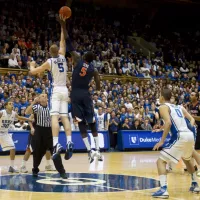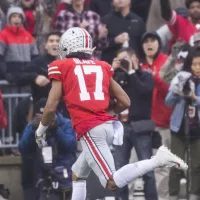The Big Ten Conference is the oldest NCAA Division I collegiate athletic conference in the U.S., established in 1896. Despite its name, it now comprises 18 member institutions and 2 affiliate members after an expansion on August 2, 2024. Based in Rosemont, Illinois, near Chicago, the conference participates in NCAA Division I, with its football teams competing at the highest level, the Football Bowl Subdivision (FBS).
1900: Nebraska's First Petition to Join the League
In 1900, Nebraska first petitioned to join the league but was turned away.
1902: Michigan Appears in First Rose Bowl
In 1902, Michigan appeared in the first bowl game, the Rose Bowl.
1902: Minnesota Awarded Title by Helms Athletic Foundation
In 1902, Minnesota was selected for national title by the Helms Athletic Foundation.
1902: Minnesota Champion for Premo-Porretta and Helms
In 1902, Minnesota was the champion for both the Premo-Porretta Power Poll and the Helms Athletic Foundation.
1903: Minnesota Premo-Porretta Champion
In 1903, Minnesota was the champion for the Premo-Porretta Power Poll.
1904: Big Ten Participates in Basketball
The Big Ten has participated in basketball since 1904.
1905: Rising Injuries and Deaths
In 1905, college football players suffered more than 325 deaths and 1,149 injuries.
1905: Conference Officially Incorporated
In 1905, the conference was officially incorporated as the "Intercollegiate Conference of Faculty Representatives".
April 1907: Michigan Voted Out of Conference
In April 1907, Michigan was voted out of the Big Ten Conference due to refusing to adhere to league rules.
1908: Chicago Wins Post-Season National Championship Series
Former member Chicago won a post-season national championship series in 1908.
1911: Nebraska's Second Petition to Join the League
In 1911, Nebraska petitioned again to join the league, but was turned away again.
1912: Wisconsin Awarded Title by Helms Athletic Foundation
In 1912, Wisconsin was selected for national title by the Helms Athletic Foundation.
1914: Wisconsin Awarded Title by Helms Athletic Foundation
In 1914, Wisconsin was selected for national title by the Helms Athletic Foundation.
1915: Illinois Awarded Title by Helms Athletic Foundation
In 1915, Illinois was selected for national title by the Helms Athletic Foundation.
December 1916: Michigan Rejoined the Conference
In December 1916, Michigan rejoined the Big Ten Conference after a nine-year absence.
1916: Wisconsin Awarded Title by Helms Athletic Foundation
In 1916, Wisconsin was selected for national title by the Helms Athletic Foundation.
1919: Minnesota Awarded Title by Helms Athletic Foundation
In 1919, Minnesota was selected for national title by the Helms Athletic Foundation.
1919: Minnesota Helms Champion
In 1919, Minnesota was the champion for the Helms Athletic Foundation.
1920: Ohio State Participates in Rose Bowl
In 1920, Ohio State Buckeyes football team participated in the Rose Bowl.
1922: Commissioner of Athletics Office Created
In 1922, the office of the commissioner of athletics was created to address athletic problems and enforce eligibility rules within the Big Ten Conference.
1926: Notre Dame Considers Joining Big Ten
In 1926, Notre Dame briefly considered joining the Big Ten but chose to retain its independent status.
1931: Northwestern Awarded Title by Helms Athletic Foundation
In 1931, the defunct Helms Athletic Foundation retrospectively awarded national titles to Northwestern.
1932: Los Angeles Memorial Coliseum hosts Summer Olympics
In 1932, the Los Angeles Memorial Coliseum, the home stadium for USC, hosted the summer Olympic Games.
1932: Purdue Awarded Title by Helms Athletic Foundation
In 1932, the defunct Helms Athletic Foundation retrospectively awarded national titles to Purdue.
1939: University of Chicago Abolishes Football Program
In 1939, University of Chicago President Robert Maynard Hutchins decided to abolish the football program.
1940: Marv Huffman of Indiana, NCAA MVP
In 1940, Marv Huffman of Indiana was named NCAA tournament MVP.
1941: John Katz of Wisconsin, NCAA MVP
In 1941, John Katz of Wisconsin was named NCAA tournament MVP.
1943: Helms Athletic Foundation Awards Titles
In 1943, the Helms Athletic Foundation retrospectively awarded national titles to Northwestern for 1931 and Purdue for 1932.
1946: Chicago Withdraws from the Conference
In 1946, the University of Chicago withdrew from the Big Ten Conference.
1946: Big Ten Champion Tie-In with Rose Bowl
Since 1946, the Big Ten champion has had a tie-in with the Rose Bowl game.
1947: Agreement Struck for Rose Bowl
In 1947, the agreement struck with the Pacific Coast Conference for the Rose Bowl.
1948: Minnesota-North Dakota Rivalry Started
In 1948, Minnesota men's ice hockey began an annual border rivalry with the University of North Dakota.
May 20, 1949: Michigan State Joins the Conference
On May 20, 1949, Michigan State University joined the Big Ten Conference, and the conference was again known as the Big Ten.
1958: University of Chicago Joins CIC
In 1958, the University of Chicago, a former Big Ten Conference member, joined the Committee on Institutional Cooperation (CIC), now known as the Big Ten Academic Alliance.
1961: Ohio State Declines Rose Bowl Bid
After the 1961 season, Ohio State declined the Rose Bowl bid due to Ohio State faculty concerns about academics.
1961: Marquette Abandons Football Program
Wisconsin and Marquette played an annual football game before Marquette abandoned its football program in 1961.
1971: Rose Bowl Consecutive Year Restriction
From 1946 through 1971, the Big Ten did not allow the same team to represent the conference in consecutive years in the Rose Bowl.
1974: Big Ten Teams in NIT
Since 1974, 13 Big Ten teams have played in the National Invitation Tournament (NIT) championship game, winning nine championships.
1978: Big Ten Leads Nation in Basketball Attendance
Since 1978, the Big Ten has led the nation in basketball attendance every season.
1982: Michigan Wins First Sudler Trophy
In 1982, Michigan won the first Sudler Trophy, a prestigious honor for collegiate marching bands.
1982: First NCAA Division I Women's Basketball Tournament
Since 1982, Big Ten women's basketball teams have played a total of six championship games in the NCAA Division I women's basketball tournament.
1984: Los Angeles Memorial Coliseum hosts Summer Olympics
In 1984, the Los Angeles Memorial Coliseum, the home stadium for USC, hosted the summer Olympic Games for the second time.
1987: Penn State NCAA Title
In 1987, Penn State won an NCAA national title in women's lacrosse.
1987: Conference Formally Adopts "Big Ten" Name
In 1987, the Big Ten Conference formally adopted the name "Big Ten" and was incorporated as a not-for-profit corporation.
1989: Penn State NCAA Title
In 1989, Penn State won an NCAA national title in women's lacrosse.
1990: Penn State Joins the Conference
In 1990, Pennsylvania State University joined the Big Ten Conference, expanding it to 11 teams.
1993: League Explored Adding Potential Schools
Around 1993, the league explored adding Kansas, Missouri and Rutgers or other potential schools, to create a 14-team league with two football divisions.
1993: Big Ten Football Schedule with Permanent Matches
From 1993 through 2010, the Big Ten football schedule was set up with each team having two permanent matches within the conference.
1993: Big Ten Women's Basketball Led in Attendance
From 1993 to 1999, Big Ten women's basketball led conference attendance.
1994: Braggin' Rights Game Moved to Enterprise Center
Since 1994, the "Braggin' Rights" game between Illinois and Missouri has been held at the Enterprise Center.
1995: Maryland Women's Lacrosse Dominance
In 1995, Maryland started a streak of seven straight NCAA national championships in women's lacrosse.
1997: Minnesota Vacates Big Ten Title
In 1997, Minnesota vacated its Big Ten Conference regular season title due to NCAA sanctions.
1998: Michigan Vacates Big Ten Tournament Title
In 1998, Michigan vacated its Big Ten tournament title due to NCAA sanctions.
1998: WNIT Tournament
Since 1998, Big Ten women's basketball teams have played a total of 10 championship games in the Women's National Invitation Tournament.
1999: Big Ten Women's Basketball Led in Attendance
From 1993 to 1999, Big Ten women's basketball led conference attendance.
1999: Notre Dame Negotiations
In 1999, Notre Dame and the Big Ten entered into private negotiations concerning a possible membership that would include Notre Dame, but the school's board of trustees decided against joining the conference.
1999: Start of ACC–Big Ten Challenge
In 1999, the Big Ten began participating in the ACC–Big Ten Challenge with the Atlantic Coast Conference.
2000: Ohio State Vacates Titles
In 2000, Ohio State vacated its regular season title due to NCAA sanctions.
2000: Penn State-Pittsburgh Football Series Ends
Penn State and Pittsburgh did not meet from 2000 until renewing their football rivalry in 2016.
2001: End of Maryland's Championship Streak
In 2001, Maryland completed their streak of seven straight NCAA national championships in women's lacrosse.
2002: Ohio State Vacates Titles
In 2002, Ohio State vacated its Big Ten tournament, as well as 2000 and 2002 regular season titles, due to NCAA sanctions.
2004: Exploration of Big Ten-Specific Channel
In 2004, Commissioner Jim Delany began exploring the formation of a Big Ten-specific channel after failing to secure larger rights fees from ESPN.
2005: Start of Northwestern's Championship Streak
In 2005, Northwestern started a streak of five straight NCAA national championships in women's lacrosse.
2005: USC Vacates Win Against Notre Dame
In 2005, the University of Southern California had a win vacated against Notre Dame.
2006: Maryland Won NCAA
In 2006 Maryland won the NCAA title as a member of the ACC.
2006: Big Ten Network Formation
In 2006, the Big Ten Conference announced the formation of a dedicated cable network, the Big Ten Network, in a 20-year partnership with Fox Sports.
2007: New Media Rights Agreement
In 2007, a new ten-year media rights agreement began, splitting Big Ten coverage among ESPN networks, CBS Sports, and Big Ten Network, ending Comcast Chicago's regional coverage of the conference.
2007: Big Ten Network Launch
In 2007, the Big Ten Network officially launched, providing coverage of Big Ten athletics, studio shows, and original programming.
2007: Big Ten–ACC Women's Challenge Founded
In 2007, the Big Ten–ACC Women's Challenge was founded, featuring women's basketball teams from both conferences.
December 2009: Big Ten Announces Expansion Plans
In December 2009, Big Ten Conference commissioner Jim Delany announced that the league was looking to expand.
2009: End of Northwestern's Championship Streak
In 2009, Northwestern completed their streak of five straight NCAA national championships in women's lacrosse.
June 11, 2010: Nebraska Applies for Membership
On June 11, 2010, the University of Nebraska applied for membership in the Big Ten.
September 1, 2010: Football Divisional Split Revealed
On September 1, 2010, Jim Delany revealed the conference's football divisional split.
December 13, 2010: Division Names and New Logo Announced
On December 13, 2010, the Big Ten Conference publicly announced its new football division names and a new logo, replacing the "hidden 11" logo with the B1G logo.
2010: Discontinuation of Big Ten Football Schedule
After the 2010 season, the Big Ten discontinued its previous football scheduling system and grouped teams into two divisions.
2010: End of the Big Ten Football Schedule with Permanent Matches
From 1993 through 2010, the Big Ten football schedule was set up with each team having two permanent matches within the conference, until 2010.
2010: Ohio State Vacates Wins and Title
In 2010, Ohio State vacated 12 wins and its Big Ten title due to NCAA sanctions.
2010: AAU Membership Important to Big Ten
In 2010, former conference commissioner Jim Delany stated that membership in the Association of American Universities (AAU) is an "important part of who we are" for the Big Ten Conference.
2010: Big Ten Football Championship Game Creation
In 2010, the Big Ten announced the creation of the Big Ten Football Championship game, starting with the 2011 season, and signed a broadcast deal with Fox to broadcast the game from 2011 through 2016.
July 1, 2011: Nebraska Officially Joins the Big Ten
On July 1, 2011, the University of Nebraska officially became the 12th member of the Big Ten Conference.
2011: Inaugural Big Ten Football Championship Game
In 2011, the Big Ten Football Championship game was played for the first time, with Fox broadcasting the game as part of a broadcast deal from 2011 through 2016.
2011: Legends and Leaders Divisional Alignment in Effect
In 2011, the Legends and Leaders divisional alignment was put into effect for the football season.
November 19, 2012: Maryland to Join the Big Ten
On November 19, 2012, the University of Maryland's Board of Regents voted to withdraw from the ACC and join the Big Ten as its 13th member effective on July 1, 2014.
2012: Legends and Leaders Divisional Alignment in Effect
In 2012, the Legends and Leaders divisional alignment was put into effect for the football season.
2012: Penn State First NCAA Division I Season
In 2012-13, Penn State played its first NCAA Division I season as an independent before joining the Big Ten for ice hockey.
April 28, 2013: Football Divisional Realignment Approved
On April 28, 2013, the Big Ten presidents and chancellors unanimously approved a football divisional realignment that went into effect when Maryland and Rutgers joined in 2014.
June 3, 2013: Big Ten Announces Sponsorship of Lacrosse
On June 3, 2013, the Big Ten announced its sponsorship of men's and women's lacrosse.
2013: Minnesota-North Dakota Rivalry Ends
In 2013, Minnesota men's ice hockey annual border rivalry with the University of North Dakota, prior to the inception of the Big Ten Conference, came to an end.
2013: Conference Headquarters Relocates
In 2013, the Big Ten Conference moved its headquarters from Park Ridge, Illinois, to Rosemont, Illinois.
2013: Legends and Leaders Divisional Alignment in Effect
In 2013, the Legends and Leaders divisional alignment was put into effect for the football season.
2013: All-Conference Teams and Awards Created
In 2013-14, the Big Ten created All-Conference Teams (first team, second team, and rookie team) and five individual trophies, voted on by coaches and a media panel. A Tournament Most Outstanding Player award and Sportsmanship Award were also created.
2013: Season Statistics Update
Information updated through the 2013-14 season.
July 1, 2014: Maryland Officially Joins the Big Ten
On July 1, 2014, Maryland officially joined the Big Ten Conference as its 13th member.
2014: Schools Joined the Big Ten
Both schools that joined in 2014, Maryland and Rutgers, won national titles before joining the Big Ten.
2014: Big Ten Realigns into East and West Divisions
For the 2014 season, the Big Ten realigned into East and West Divisions with the addition of Maryland and Rutgers.
2014: Johns Hopkins Joins as Affiliate Member
In 2014, Johns Hopkins University joined the Big Ten Conference as its first affiliate member for men's lacrosse.
2014: Johns Hopkins Joins Big Ten in Men's Lacrosse
In 2014, Johns Hopkins joined the Big Ten as an affiliate member in men's lacrosse.
2014: Maryland and Rutgers join the Big Ten
In 2014, Maryland and Rutgers joined the Big Ten.
2014: Conference Geographic Footprint Extends
In 2014, the Big Ten Conference's geographic footprint extended from the Mid-Atlantic to the Great Plains, marking a shift from its primarily Midwestern presence.
2014: New Geographic Football Divisions
In 2014, the Big Ten implemented new geographic football divisions, dividing the conference into the West and East divisions with Maryland and Rutgers joining the conference.
2014: Big Ten Division Names Changed
In 2014, when Maryland and Rutgers joined the Big Ten, the division names were changed to "East" and "West".
2015: Big Ten Considers Exceptions to Power Five Rule
In 2015, ESPN reported that the Big Ten would allow exceptions to the Power Five rule on a case-by-case basis, and that Army had been added to the list of non-Power Five schools that would be counted as Power Five opponents.
2015: Start of Gavitt Tipoff Games
In 2015, the Big Ten began participating in the Gavitt Tipoff Games with the Big East Conference.
2015: Big Ten Sponsors Men's Lacrosse
In the 2015 season, the Big Ten began sponsoring men's lacrosse.
March 23, 2016: Notre Dame to Become Hockey Affiliate
On March 23, 2016, it was announced that Notre Dame would become a Big Ten affiliate in men's ice hockey beginning with the 2017-18 season.
June 29, 2016: University of Chicago Leaves CIC
On June 29, 2016, the University of Chicago, a former Big Ten Conference member, ended its membership of the Committee on Institutional Cooperation (CIC).
July 1, 2016: Johns Hopkins Joins Big Ten Women's Lacrosse
As of July 1, 2016, Johns Hopkins became the seventh women's lacrosse program in the Big Ten.
2016: Big Ten Adopts Nine-Game Conference Schedule
Beginning in 2016, the Big Ten adopted a nine-game conference schedule and no longer allowed members to play Football Championship Subdivision (FCS) teams.
2016: Johns Hopkins Women's Lacrosse Joins Big Ten
In 2016, Johns Hopkins women's lacrosse joined the Big Ten as an affiliate member.
2016: Minnesota-North Dakota Rivalry Resumes
In 2016, Minnesota men's ice hockey border rivalry with the University of North Dakota resumed in non-conference action.
2016: New Media Rights Deal Announced
In 2016, the Big Ten Conference announced a new six-year media rights deal worth $2.64 billion with Fox Sports, CBS Sports, and ESPN, to take effect at the start of the 2017–18 season.
2016: End of Fox Broadcast Deal for Championship Game
In 2016, the initial broadcast deal with Fox to broadcast the Big Ten Football Championship game came to an end.
2016: End of Media Rights Agreement
In 2016, the ten-year media rights agreement that split Big Ten coverage among ESPN networks, CBS Sports, and Big Ten Network, came to an end.
2016: Penn State-Pittsburgh Football Series Renewed
Penn State and Pittsburgh renewed their football rivalry with an alternating home-and-home series from 2016 to 2019.
2017: New Media Rights Deal Takes Effect
At the start of the 2017-18 season, a new six-year media rights deal between the Big Ten Conference, Fox Sports, CBS Sports, and ESPN took effect.
2017: Notre Dame Joins Big Ten Hockey as Affiliate Member
Beginning with the 2017-18 season, Notre Dame joined the Big Ten as an affiliate member for men's ice hockey.
2017: Notre Dame Begins Hockey Affiliation
In 2017, Notre Dame became a men's ice hockey affiliate member.
2017: Big Ten Allows FCS Opponents Under Specific Conditions
In 2017, the Big Ten started to allow teams to schedule an FCS opponent during years in which they only have four conference home games.
2017: Notre Dame Joins Big Ten in Ice Hockey
In the 2017–18 school year, Notre Dame joined the Big Ten as an affiliate member in men's ice hockey.
2017: Nebraska Receives Full Share of Media Revenue
In the fall of 2017, Nebraska began receiving a full share of the media revenue as part of its agreement to join the Big Ten.
2018: Conference Opponent Records Updated
Team's records against conference opponents were updated as of the end of the 2018-19 season.
2019: Maryland Wins NCAA Title
In 2019, Maryland won their most recent NCAA national championship in women's lacrosse.
2019: Penn State-Pittsburgh Football Series Ends
In 2019, Penn State and Pittsburgh ended their alternating home-and-home football series.
2020: Arizona State Scheduling Agreement
For the 2020-21 season, Arizona State had a scheduling agreement with the Big Ten, playing all seven teams four times, but was not a conference member.
2021: Big Ten Loses Gavitt Tipoff Games Challenge
In 2021, the Big Ten lost the Gavitt Tipoff Games challenge against the Big East Conference.
2021: End of First Football Schedule Pairing Cycle
In 2021, the first cycle of football schedule pairings that began in 2016 ended, and the Big Ten moved on to a new set of cross-division opponents, except for Indiana and Purdue.
2021: Revenue Reporting by Knight Commission
In 2021-22 academic year, revenue specifically from NCAA/Conference Distributions, Media Rights, and Post-Season Football was reported by the Knight Commission.
March 1, 2022: Win Percentage List Update
This list is updated through March 1, 2022 and is listed by win percentage in NCAA Division I men's college basketball.
June 30, 2022: UCLA and USC to Join Big Ten
On June 30, 2022, UCLA and USC announced they would join the Big Ten Conference effective August 2, 2024.
August 18, 2022: New Broadcast Rights Deals Announced
On August 18, 2022, the Big Ten announced seven-year broadcast rights deals with Fox, CBS, and NBC Sports, beginning in the 2023-24 academic year, ending its association with ESPN dating back to the 1980s.
2022: Big Ten Rivalry Records Updated
As of the completion of the 2022 season, Big Ten Conference rivalries' totals and records were updated.
2022: End of Media Rights Deal
At the end of the 2022-23 season, the six-year media rights deal between the Big Ten Conference, Fox Sports, CBS Sports, and ESPN came to an end.
2022: DOE Equity in Athletics Website Reporting
For the 2022-23 academic year, institutional reporting to the United States Department of Education was shown on the DOE Equity in Athletics website.
2022: End of ACC–Big Ten Challenge
In 2022, the Big Ten finished participating in the ACC–Big Ten Challenge with the Atlantic Coast Conference.
2022: Big Ten–ACC Women's Challenge Ended
In 2022, the Big Ten–ACC Women's Challenge ended after 15 years. The Big Ten's record in the challenge was 1–11–3.
2022: Season Statistics Update
Information updated through the 2022 season.
2022: Conference Championship Totals Updated
Totals for conference regular-season and tournament championships include those won before the schools played Big Ten hockey, updated through the 2022-23 season.
June 2023: Big Ten Eliminates Football Divisions
In June 2023, the Big Ten Conference announced it would eliminate its East and West football divisions starting in 2024. The new format ensures each team plays nine conference games, with a system in place to face every other team at least twice within four years and the top two teams will play in the Big Ten Football Championship Game.
August 4, 2023: Oregon and Washington to Join Big Ten
On August 4, 2023, Oregon and Washington announced that they would join the Big Ten Conference alongside UCLA and USC.
2023: Final Season of West and East Division
2023 was the final season for the West and East divisional alignment in the Big Ten.
2023: National University Rankings
As of 2023, U.S. News & World Report published National University rankings.
2023: BYU Joins Big 12
In 2023, BYU joined the Big 12, games against them count toward the Power Five requirement.
2023: End of Gavitt Tipoff Games
In 2023, the Big Ten concluded its participation in the Gavitt Tipoff Games with the Big East Conference.
2023: End of Football Schedule Pairings
In 2023, the Big Ten's football schedule pairings which started in 2022 ended, setting the stage for further scheduling adjustments in the future.
2023: New Broadcast Rights Deals Begin
In the 2023-24 academic year, the Big Ten's new seven-year broadcast rights deals with Fox, CBS, and NBC Sports, began. This also marked the end of its association with ESPN.
March 31, 2024: NCAA Gymnastics Statistics Updated
NCAA gymnastics history updated through March 31, 2024.
August 2, 2024: Conference Expands to 18 Members
On August 2, 2024, the Big Ten Conference expanded to include a total of 18 member institutions and 2 affiliate institutions.
2024: Big Ten Leads in Large Basketball Arenas
As of the upcoming 2024–25 season, the Big Ten Conference has the most on-campus basketball arenas with seating capacities of 15,000 or more of any NCAA conference, with seven.
2024: Protected Matchups in Big Ten
Beginning in 2024, the Big Ten Conference will eliminate divisions but will protect certain matchups.
2024: NBC Airs Big Ten Basketball Games on Broadcast Network
In 2024, NBC aired some of its Big Ten basketball games on its broadcast network, rather than Peacock.
2024: Washington, Oregon, USC and UCLA join the Big Ten
In 2024, Washington, Oregon, USC and UCLA joined the Big Ten.
2024: Conference Gains West Coast Presence
In 2024, the Big Ten Conference established a presence on the West Coast by adding four schools from the former Pac-12 Conference.
2024: Big Ten Football Divisions Eliminated
In 2024, the Big Ten eliminated East and West divisions for football. Each team began playing nine conference games, with a system guaranteeing at least two games against every other team within a four-year span. The top two teams in the standings will compete in the Big Ten Football Championship Game.
2024: Big Ten Expands and Eliminates Divisions
In 2024, the addition of Oregon, UCLA, USC, and Washington expanded the Big Ten to 18 teams, resulting in the elimination of football divisions. The conference adopted the "Flex Protect Plus" model, later tweaked into the "Flex Protect XVIII" model.
2024: Stadium Capacities and Future Olympic Hosting
In 2024, three Big Ten football stadiums, Michigan Stadium, Beaver Stadium, and Ohio Stadium, seat over 100,000 spectators. USC's home stadium, the Los Angeles Memorial Coliseum, will host the summer Olympic Games again in 2028, having previously hosted in 1932 and 1984.
2024: Salary Information Disclosure
In 2024, three Big Ten member schools—Northwestern and USC, private institutions, and Penn State are not obligated to provide salary information for their head coaches.
2024: Season Statistics Update
Information updated through the 2024 season.
2024: WBIS Tournament
Since 2024, Big Ten women's basketball teams have played one in the Women's Basketball Invitation Tournament.
2024: Record Inclusion for New Teams
The record prior to joining the conference in 2024 is not included.
2024: Oregon and USC Arrive
With the 2024 arrival of Oregon and USC, the Big Ten women's lacrosse roster increased to nine teams.
January 20, 2025: List Update Cutoff
This list goes through January 20, 2025.
2025: Flex Protect Plus Model in Operation
For at least 2024 and 2025, the Big Ten Conference adopted the "Flex Protect Plus" model, which called for each conference member to play all the others at home and away at least once during a four-year cycle.
2026: Big Ten Championship Game Rights Issue
In 2026, the conference would have to compensate Fox $40 million for the Big Ten championship game, as the conference did not actually have the right to offer the game to NBC.
2026: Ryan Field Future
The text mentions Ryan Field and the year 2026 in the context of future events.
2028: Los Angeles Memorial Coliseum to host Summer Olympics
In 2028, the Los Angeles Memorial Coliseum, the home stadium for USC, is scheduled to host the summer Olympic Games for the third time.
2028: End of Flex Protect XVIII Model Planned
The Big Ten's "Flex Protect XVIII" scheduling model, which maintains 11 protected rivalries while adding Oregon–Washington, is planned to operate from 2024 to 2028.
2029: Future Media Deal for Oregon and Washington
Through the 2029-30 season, Oregon and Washington will receive a reduced media revenue share, with the share increasing by $1 million each year for each school, and will receive a full share with the next media deal.
Mentioned in this timeline

Basketball is a team sport played on a rectangular court...
CBS Broadcasting Inc CBS is a prominent American commercial broadcast...
California is a U S state on the Pacific Coast...

College football is a popular amateur sport in the United...

College basketball in the U S is governed by bodies...
The National Broadcasting Company NBC is a major American commercial...
Trending

8 months ago Chris Olave Trade Rumors Surface Amidst Derek Carr's Retirement and Eagles Interest

2 months ago Michael Vick vs. DeSean Jackson: Norfolk State faces Delaware State in Week 10

8 months ago Bank of America: Shareholders Approve Executive Pay, Elect Directors, and Equity Plan Changes

Malcolm-Jamal Warner is an American actor musician and poet best known for his role as Theodore Huxtable on the iconic...

5 months ago Sundance Film Festival's Final Utah Edition: Egyptian Theatre Excluded, Gratitude Celebrated.

Nancy Pelosi is a prominent American politician notably serving as the nd Speaker of the House of Representatives twice -...
Popular

Stranger Things created by the Duffer Brothers is a popular...

XXXTentacion born Jahseh Dwayne Ricardo Onfroy was a controversial yet...
The Kennedy Center Honors are annual awards recognizing individuals and...
Turning Point USA TPUSA is an American nonprofit organization founded...

Candace Owens is an American conservative political commentator and author...

William Franklin Graham III commonly known as Franklin Graham is...